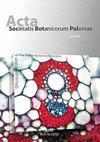Long-Term Changes in Spatial Patterns and Life-Stage Structure in a Population of Senecio umbrosus Waldst. et Kit. Along With the Transformation of Grassland Vegetation
IF 1.1
4区 生物学
Q3 PLANT SCIENCES
引用次数: 2
Abstract
This paper was a part of studies conducted within an island population of the ragwort Senecio umbrosus (White Mt, southeastern Poland), a vulnerable element of xerothermic grasslands. Special attention was paid to the effects of expansive grass encroachment vs. grassland burning episodes on spatiotemporal patterns and life-stage structure of individuals in the population. The population traits were investigated nine times from 1990 to 2010, within three permanent patches differing in soil properties, initial floristic composition, grassland cover (particularly the cover of Brachypodium pinnatum), ragwort cover and density, shrub/tree cover influencing light intensity (full light–shadow), and grassland burning (zero–six episodes). There was a drastic decline in ragwort abundance within all the study patches accompanied by a decrease in the population clustering coefficient and a gradual equalization of the spatial distribution of ramets. The abundance was negatively correlated (PCA analysis) with an increase in B. pinnatum cover and positively correlated with the number of burning episodes, which temporarily delimited persistent litter cover and facilitated recruitment of new individuals. The decrease in ramet abundance ranged from 3.8 times (medium-high, moderately shadowed grassland; six cases of burning) to 8.3 times (high, dense, and shadowed grassland; four cases of burning). The patch of low, loose, sunlit, and never-burned grassland with the greatest initial density of ragwort (a 6.8-fold decrease in abundance) has evolved with time into a high and dense grassland with a greater coverage of B. pinnatum and Calamagrostis epigejos, additionally shaded by shrubs and young trees.千里光种群空间格局和生命阶段结构的长期变化。et套件。随着草原植被的转变
这篇论文是在豚草(波兰东南部White Mt)的岛屿种群中进行的研究的一部分,豚草是干热草原的一种脆弱元素。特别关注了扩张性草地侵蚀和草地焚烧事件对种群中个体时空模式和生命阶段结构的影响。从1990年到2010年,在三个永久性斑块内对种群特征进行了九次调查,这些斑块在土壤性质、初始区系组成、草地覆盖(特别是羽状短梗的覆盖)、豚草覆盖和密度、影响光强的灌木/树木覆盖(全光-阴影)和草地焚烧(零-六次)方面存在差异。在所有研究斑块中,豚草的丰度都急剧下降,同时种群聚类系数降低,分株的空间分布逐渐均衡。该丰度与羽状芽孢杆菌覆盖率的增加呈负相关(PCA分析),与焚烧次数呈正相关,这暂时限制了持续的枯枝落叶覆盖率,并促进了新个体的招募。分株丰度的下降幅度从3.8倍(中高、中度阴影草地;6例焚烧)到8.3倍(高、密集、阴影草地;4例焚烧)。随着时间的推移,豚草初始密度最大(丰度下降了6.8倍)的一片低矮、疏松、阳光充足、从未被烧毁的草地已经演变成一片高密度的草地,羽状芽孢杆菌和卡拉马戈罗斯提斯表观草覆盖率更高,此外还有灌木和幼树遮荫。
本文章由计算机程序翻译,如有差异,请以英文原文为准。
求助全文
约1分钟内获得全文
求助全文
来源期刊
CiteScore
2.00
自引率
10.00%
发文量
18
审稿时长
1 months
期刊介绍:
The journal has been published since 1923 and offers Open Access publication of original research papers, short communications, and reviews in all areas of plant science, including evolution, ecology, genetics, plant structure and development, physiology and biochemistry.

 求助内容:
求助内容: 应助结果提醒方式:
应助结果提醒方式:


